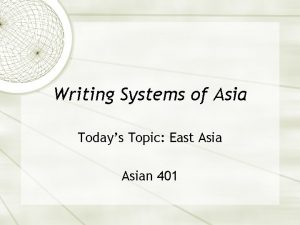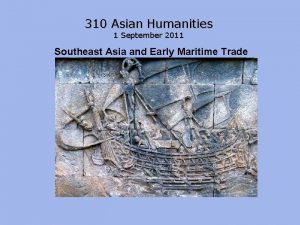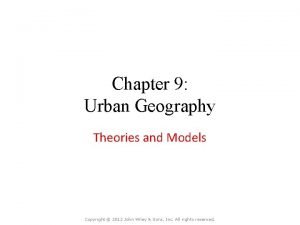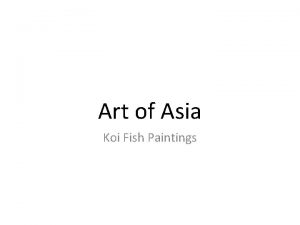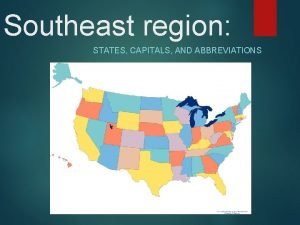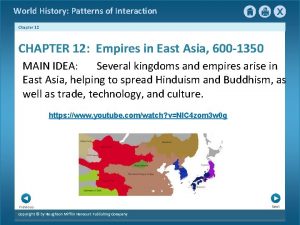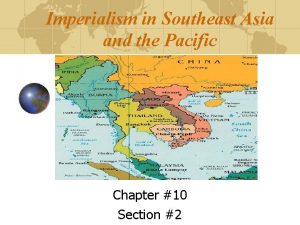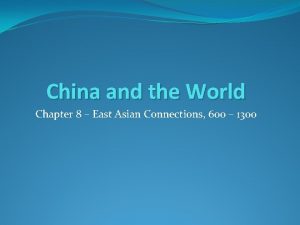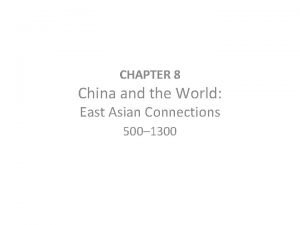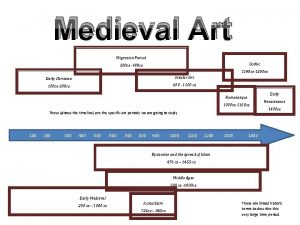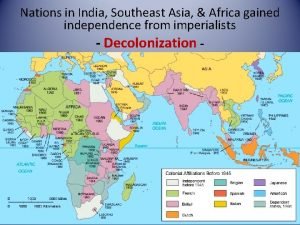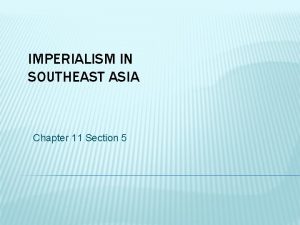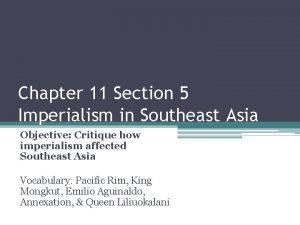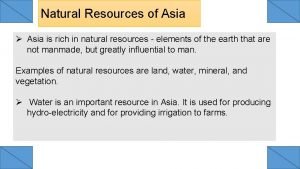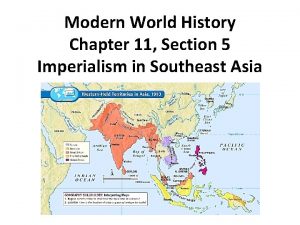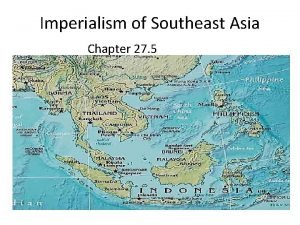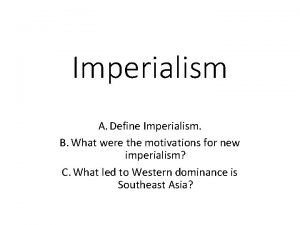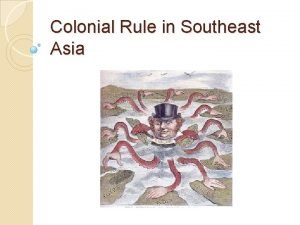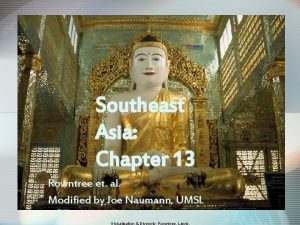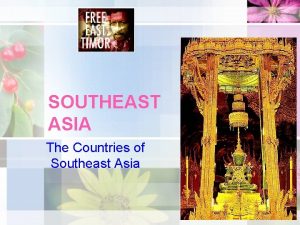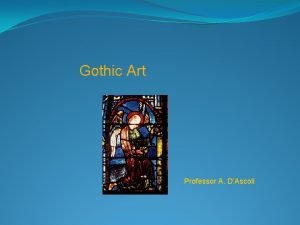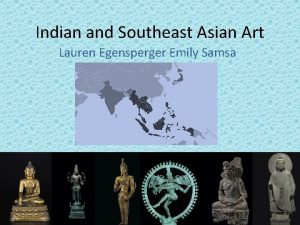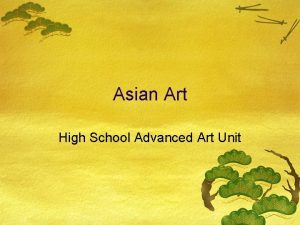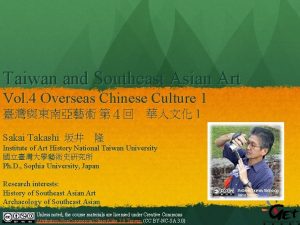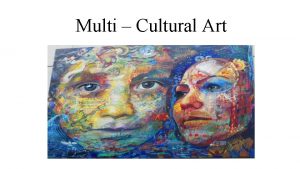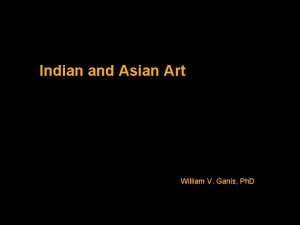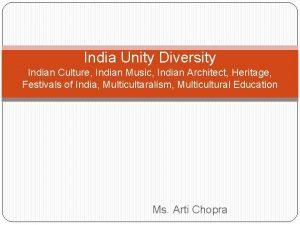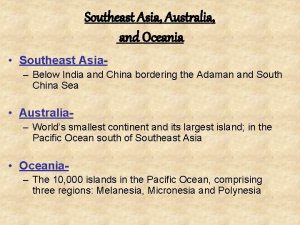Indian and SouthEast Asian Art Professor A DAscoli






























































- Slides: 62

Indian and South-East Asian Art Professor A. D’Ascoli


Indian Civilization • 2500 – 1550 BCE Indus Valley & Saraswati Civilizations – built cities of Mohenjo-Daro and Harappa • 1500 BCE – Hinduism develops • 1000 – 600 BCE – Vedic Period (Aryan Migrations) • 8 th century BCE – Caste system is firmly established • 6 th – 5 th centuries BCE – Jainism and Buddhism appear • 563 – 483 BCE – Life of Gautama Buddha

Indian Civilization • 326 BCE – Alexander the Great invades India • 324 – 301 BCE – Chandragupta Maurya rules and establishes an Indian Empire (established by Alexander as ruler in his name) • 269 – 232 BCE – Ashoka rules – Buddhism spreads • 250 BCE – Sarnath is made capital of India • 1 st century BCE – Bhagavad Gita is written

Caste System • Indian society is divided into 4 distinct classes or castes: • (1) Brahmins – priests, leaders, seers and religious authorities; • (2) Kshatriyas – originally the kings and warriors of the ancient past, now they are the administrators, politicians and civil authorities; • (3) Vaishyas – businessmen, merchants, traders, doctors, lawyers, teachers, etc. ; and • (4) Shudras – they are the laborers, the servant class. • However, even beneath the Shudras are the Outcastes – called the ‘untouchables’ – these are members of Indian society who fall outside of any of the castes and are therefore avoided by

Indian Civilization • 4 Major religions exist in India today – 3 which are indigenous • Jainism • Buddhism • Muslim • Hinduism

Indian Religions - Hinduism • Origins are unknown (1500 – 500 BCE) • Hindu derives from Sanskrit word for Indus River • Hindu worship focuses on a pantheon of gods who personify the forces of nature (not an historical person or prophet) • At the center of the Hindu religion is the idea of Brahman – the indivisible essence of all spiritual reality, the divine source of all being

Indian Religions - Hinduism • Brahman’s 3 functions are divided into 3 gods: • (1) Brahma – the creator – not the same as Brahman; • (2) Vishnu – the preserver; and • (3) Shiva – the destroyer.

Brahman: Essence of Reality v. He is not ultimate reality because he can be visualized. v. Brahma’s life span = each day is 1000 times the whole of human history. v. The world will end with the appearance of Vishnu and is about 4000 years from now.

Indian Religions - Hinduism • The idea of kharma is also central to Hindi thought • Kharma means action, however the concept of kharma involves moral cause and effect (you get what you put out) • People’s accumulation of these moral actions will determine the form in which he or she will reincarnate • Because of this people’s current condition (poor, deformed, etc) is believed to have been caused by your previous misuse of your earlier existence • Ancient Hindu society reflects these religious beliefs in their caste system.

9 Basic Hindu Beliefs • Hindus believe in a one, all-pervasive Supreme Being who is both immanent and transcendent, both Creator and Unmanifest Reality. • Hindus believe in the divinity of the four Vedas, the world's most ancient scripture, and venerate the Agamas as equally revealed. These primordial hymns are God's word and the bedrock of Sanatana Dharma, the eternal religion. • Hindus believe that the universe undergoes endless cycles of creation, preservation and dissolution. • Hindus believe in karma, the law of cause and effect by which each individual creates his own destiny by his thoughts, words and deeds.

9 Basic Hindu Beliefs • Hindus believe that the soul reincarnates, evolving through many births until all karmas have been resolved, and moksha, liberation from the cycle of rebirth, is attained. Not a single soul will be deprived of this destiny. • Hindus believe that divine beings exist in unseen worlds and that temple worship, rituals, sacraments and personal devotionals create a communion with these devas and Gods. • Hindus believe that an enlightened master, or satguru, is essential to know the Transcendent Absolute, as are personal discipline, good conduct, purification, pilgrimage, self-inquiry, meditation and surrender in God. • Hindus believe that all life is sacred, to be loved and revered, and therefore practice ahimsa, noninjury, in thought, word and deed. • Hindus believe that no religion teaches the only way to salvation above all others, but that all genuine paths are facets of God's Light, deserving tolerance and understanding.

Hinduism • http: //indianterrorism. bravepages. com/hind uextremismup. htm • http: //www. pakistankakhudahafiz. com/201 1/03/30/hindu-extremism-and-christianpersecution-in-india/

THE TWO MOST POPULAR GODS SHIVA VISHNU

Avatars of Vishnu Krishna Rama

Goddesses Lakshmi Saraswati

Kali v Wife of Shiva v. Black in color & wearing a necklace of skulls. v. She is a bloodthirsty goddess. v. A violent destroyer of her enemies vaffectionate and caring for her devotees. .

The Ganges River Falling from its source of Vishnu’s feet onto Shiva’s head and out from his hair, the water of the Ganges is sacred enough to purify all sins.

Indian Religions - Jainism • The ultimate goal of Jainism is the same as in Buddhism and Hinduism – which is the escape from the cycle of samsara (the transmigration of the soul (reincarnation) • Jainism, more than any other Indian religion, focuses on self-reliance and responsibility for one’s own fate • Jainism is a very ethical faith – it emphasizes virtue, self-control and non-violence to all life forms

Indian Religions - Buddhism • The historical Buddha was born Siddharta Gautama Sakya (563 – 483 BCE) and was a prince of a kingdom in the foothills of the Himalayas, in present day Nepal. He is also known as Sayakamuni (the sage) • He achieved enlightenment and then traveled the countryside preaching and educating others on the path to enlightenment. • He taught the importance of the Middle Path – rejecting both extremes – those of asceticism which only weakens the mind and the body and indulgence which obstructs wisdom

Indian Religions - Buddhism • Buddha set forth the Four Noble Truths and Eightfold Path of the dharma (religious truth or law) • The 4 Noble truths are: • (1) Life consists of suffering, impermanence, imperfection and incompleteness; • (2) the cause of life’s suffering is selfishness; • (3) Suffering and selfishness can be brought to an end; • (4) The answer to life’s problems of suffering is the eightfold Path.

Indian Religions - Buddhism • • • The Eightfold path consists of: (1) knowledge of the 4 Noble Truths; (2) right aspiration to the goal of enlightenment (nirvana); (3) right speech that is honest and charitable; (4) right conduct – no drinking, killing, lying or having lust; (5) right living according to the goals of Buddhism; (6) right effort; (7) right thinking with a focus on self-awareness; and (8) right use of meditation to achieve enlightenment.

Buddhism - extremists • http: //www. compassdirect. org/english/cou ntry/bangladesh/17879 • http: //www. catholicnewsagency. com/news/ buddhist_extremists_brutally_attack_catho lic_church_in_sri_lanka/

Great bath Mohenjo-daro Pakistan 2600 -1900 B. C. E. Oldest South East Asian city

Robed Male Figure from Mohenjo-daro, Pakistan ca. 2000 -1900 B. C. E. steatite 6 7/8 in. high

Indian Art • • Indus Valley Seals 3000 – 1500 BCE Indus Valley, India Cared in intaglio (negative relief) • Written language that is still undeciphered above animal designs


Indian Art • • • Ganesha 12 th century CE Southern Deccan Karnataka, India • From Hoyshala Period when Hinduism was enjoying a resurgence • Ganesha is a Hindu god that is associated with playfulness and prosperity

Indian Art • • Lion Capital 250 BCE Sarnath, India Mauryan era – erected by Ashoka to mark a place of significance to the Buddha • As lions are powerful animals – so Buddha was a powerful teacher

Indian Art • • Great Stupa 3 rd century BCE Sanchi, India The stupa is the central symbol of the Buddhist faith ( a temple) • These stupa contain relics of the Buddha • 60 ft in diameter and 25 ft high


Indian Art • • Gate of the Great Stupa 3 rd – 1 st centuries BCE Sanchi, India The gate is inscribed and carved with tales from the life of the Buddha as well as stories from the epic Jataka tales • Over 30 feet high – there are 4 in total

Great Stupa - detail Sanchi, India first century B. C. E. to first century C. E.

Chaitya Hall Karle, India ca. 100 C. E.

Chaitya Hall Karle, India ca. 100 C. E.

halo of enlightenment ushnisha urna elongated ears mudra chakra prana Seated Buddha from Mathura, India 2 nd century C. E. red sandstone 27 1/2 in. high

Indian Art • • • Seated Buddha 2 nd – 3 rd century CE Peshawar District, Pakistan From Kushan era The Kushans are credited with creating the first anthropomorphic icons of the Buddha • Greco-Roman influences in robe

Indian Art • • Standing Buddha 4 th – 5 th century CE Mathura, India Gupta Period work of art • The Buddha stands in calm serenity • Robe is sheer breaking from Greco-Roman traditions

Indian Art • • • Boshisattva Padmapani 5 th century CE Ajanta Caves, India Gupta period painting The serenity in his face reflects compassion • Painted in the traditional tribhanga pose (Standing figure with a slightly scurved body, weight shifted to one leg)

Indian Art • • Kandariya Mahadeo Temple 1025 – 1050 CE Khajuraho, India The largest tower is over 100 feet tall There are 84 smaller towers Placed on a masonry platform to add to its height and promote its majesty Full of erotic relief sculpture

Indian Art • • Taj Mahal Agra, India 1630 -1648 CE This is actually a mausoleum • Built by Shah Jahan as a tribute to his wife Mumatz Mahal • Islamic influence is clearly seen here

Indian Art • Shiva Nataraja (Lord of the Dance) • 11 th – 12 th century CE • Chola, India • This is probably the most famous of Indian icons • Shiva symbolizes both the creative and destructive forces in the universe • A ring of fire surrounds him as his hair flies out in both directions

Indian Art • Tirumala Sri Venkateswara • 16 th century CE • Tirupati, India • Temple complex covers over 2 acres of land

Indian Art • • Sabarimala Temple 800 -1000 CE Kerala, India Series of Pilgrimage Temples where strict rules must be followed to enter • Only men, women in menopause over 50 or girls under 10 are allowed inside

Indian Art • • Akshradham Temple 2005 CE Delhi, India Built to represent the Hindu religion in allegory • 141 feet high

Indian Art • • Lotus Bah’ai Temple 1986 Delhi, India Home of the Ba’hai faith in India • Built to represent a Lotus flower • In Ba’hai faith all religions are welcome to come and worship god in whatever form

Indian Art • Golden Temple (Hari Mandir) • 1581 -1606 CE • Amritsar, India • A spot where the Buddha and several Gurus used to meditate, it was formerly a small rock in a lake surrounded by a forest

Indian Erotic Art

Indian Erotic Art

Southeast Asian Art

Bamayan Buddhas (destroyed) Bamayan, Afghanistan 3 rd century C. E. 150 feet tall

Bamayan Buddhas (destroyed) Bamayan, Afghanistan 3 rd century C. E. 150 feet tall

Death of the Buddha (Parinirvana) Gal Virhara, Sri Lanka 11 th - 12 th century C. E.

Cosmic Mountain Borobudur, Java, Indonesia ca. 800 C. E. 400 ft. wide

Angkor, Cambodia 12 th century C. E.

Angkor Wat Angkor, Cambodia 12 th century C. E.

Angkor Wat Angkor, Cambodia 12 th century C. E.


Towers of the Bayon Angkor Thom, Cambodia 12 th to 13 th centuries C. E.

Towers of the Bayon Angkor Thom, Cambodia 12 th to 13 th centuries C. E.

Bagan, Myanmar (formerly Burma): Ancient temples and pagodas, including Sunset Temple (1057). 1057 -1287. 16 square miles.

The End. . . Next lecture China & Japan
 Southeast asian alphabets
Southeast asian alphabets Tonogenesis
Tonogenesis Empires in southeast asia
Empires in southeast asia The southeast asian ministers of education organization
The southeast asian ministers of education organization Blockbusting definition ap human geography
Blockbusting definition ap human geography Southeast asian architecture
Southeast asian architecture African coty model
African coty model African city model
African city model Latin america urban model
Latin america urban model Latin america city model
Latin america city model Promotion from assistant to associate professor
Promotion from assistant to associate professor Asian fish drawing
Asian fish drawing The greatest contributors to our present gymnastics program
The greatest contributors to our present gymnastics program Southeast states and capitals and abbreviations
Southeast states and capitals and abbreviations Insular and mainland southeast asia
Insular and mainland southeast asia Chapter 12 section 5 kingdoms of southeast asia and korea
Chapter 12 section 5 kingdoms of southeast asia and korea Imperialism in southeast asia and the pacific
Imperialism in southeast asia and the pacific China and the world east asian connections
China and the world east asian connections Chapter 8 china and the world east asian connections
Chapter 8 china and the world east asian connections What is a key stone species
What is a key stone species Black and asian counselling network
Black and asian counselling network Non traditional art
Non traditional art Global consumer culture positioning example
Global consumer culture positioning example Book of kells time period
Book of kells time period Southeast trade winds
Southeast trade winds What is the southeast region of the united states
What is the southeast region of the united states Physical features of the southeast
Physical features of the southeast Chapter 21 section 1 landforms and resources answer key
Chapter 21 section 1 landforms and resources answer key Navfac southwest organizational chart
Navfac southwest organizational chart Is india southeast asia
Is india southeast asia Joint personal property shipping office
Joint personal property shipping office Southeast rpdc
Southeast rpdc Imperialism in southeast asia chapter 27 section 5
Imperialism in southeast asia chapter 27 section 5 Code compliance fort worth texas
Code compliance fort worth texas Climate regions in east asia
Climate regions in east asia Chapter 11 section 5 imperialism in southeast asia
Chapter 11 section 5 imperialism in southeast asia Chapter 25 lesson 2 empire building in africa
Chapter 25 lesson 2 empire building in africa Lesson 1 physical geography of southeast asia
Lesson 1 physical geography of southeast asia Chapter 27 section 5 imperialism in southeast asia
Chapter 27 section 5 imperialism in southeast asia Southeast seattle education coalition
Southeast seattle education coalition Southeast fisheries science center
Southeast fisheries science center Ano ibig sabihin ng seato
Ano ibig sabihin ng seato Southeast region facts
Southeast region facts Oil water separator service near me
Oil water separator service near me Malaysia rich in natural resources
Malaysia rich in natural resources Chapter 11 section 5 imperialism in southeast asia
Chapter 11 section 5 imperialism in southeast asia Imperialism in southeast asia chapter 27 section 5
Imperialism in southeast asia chapter 27 section 5 Define imperialize
Define imperialize Colonial rule in southeast asia
Colonial rule in southeast asia Psug southeast
Psug southeast Timucua tribe tools
Timucua tribe tools Southeast asia spice chart
Southeast asia spice chart Landforms in the southeast region
Landforms in the southeast region Southeast university mba cost
Southeast university mba cost Southeast community health center
Southeast community health center Weaving the web of an indian ocean world
Weaving the web of an indian ocean world Countries in southeast asia
Countries in southeast asia Southeast halifax high school
Southeast halifax high school Countries in southeast asia
Countries in southeast asia South east linuxfest
South east linuxfest Seapil
Seapil Northeast, southeast, northwest, southwest
Northeast, southeast, northwest, southwest Insular southeast asia
Insular southeast asia
